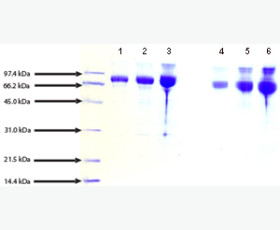Recombinant Human Apolipoprotein D/ApoD
| Product name: | Recombinant Human Apolipoprotein D/ApoD |
| Source: | Human Cells |
| Purity: | Greater than 95% as determined by reducing SDS-PAGE. |
| Buffer Formulation: | Lyophilized from a 0.2 μm filtered solution of 20mM PB, 150mM NaCl, pH 7.2. |
| Applications: | Applications:SDS-PAGE; WB; ELISA; IP. |
| Storage: | Avoid repeated freeze/thaw cycles. Store at 2-8 oC for one month. Aliquot and store at -80 oC for 12 months. |
| UOM: | 100ug/50ug/200ug/1mg/1g |
| Source | Human Cells |
| Description | Recombinant Human Apolipoprotein D is produced by our Mammalian expression system and the target gene encoding Glu21-Ser189 is expressed with a 6His tag at the C-terminus. |
| Names | Apolipoprotein D, Apo-D, ApoD, APOD |
| Accession # | P05090 |
| Formulation | Lyophilized from a 0.2 μm filtered solution of 20mM PB, 150mM NaCl, pH 7.2. |
| Shipping |
The product is shipped at ambient temperature. |
| Reconstitution |
Always centrifuge tubes before opening. Do not mix by vortex or pipetting. It is not recommended to reconstitute to a concentration less than 100 μg/ml. Dissolve the lyophilized protein in ddH2O. Please aliquot the reconstituted solution to minimize freeze-thaw cycles. |
| Storage |
Lyophilized protein should be stored at < -20°C, though stable at room temperature for 3 weeks. Reconstituted protein solution can be stored at 4-7°C for 2-7 days. Aliquots of reconstituted samples are stable at < -20°C for 3 months. |
| Purity |
Greater than 95% as determined by reducing SDS-PAGE. |
| Endotoxin | Less than 0.1 ng/µg (1 IEU/µg) as determined by LAL test. |
| Amino Acid Sequence |
QAFHLGKCPNPPVQENFDVNKYLGRWYEIEKIPTTFENGRCIQANYSLMENGKIKVLNQELRADG TVNQIEGEATPVNLTEPAKLEVKFSWFMPSAPYWILATDYENYALVYSCTCIIQLFHVDFAWILA RNPNLPPETVDSLKNILTSNNIDVKKMTVTDQVNCPKLSVDHHHHHH
|
| Background | Apolipoprotein-D (ApoD) is an atypical apolipoprotein and, based on its primary structure, it also a member of the lipocalin family. ApoD is mainly associated with high density lipoproteins in human plasma. ApoD is expressed in numerous tissues having high levels of expression in spleen, testes and brain. ApoD plays a role in maintenance and repair within the central and peripheral nervous systems. ApoD occurs in the macromolecular complex with lecithin-cholesterol acyltransferase. It is a multi-ligand, multi-functional transporter and transports a ligand from 1 cell to another. ApoD is probably involved in the transport and binding of bilin, it appears to be able to transport a variety of ligands in a number of different contexts. |














